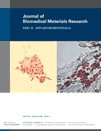Prosecká E, Rampichová M, Vojtová L, Tvrdík D, Melčáková S, Juhasová J, Plencner M, Jakubová R, Jančář J, Nečas A, Kochová P, Klepáček J, Tonar Z, Amler E. J Biomed Mater Res A. 2011 Nov;99(2):307–15. doi: 10.1002/jbm.a.33189. Epub 2011 Aug 19. IF: 3.044

Department of Biophysics
Abstract
Collagen/hydroxyapatite (HA) composite scaffolds are known to be suitable scaffolds for seeding with mesenchymal stem cells (MSCs) differentiated into osteoblasts and for the in vitro production of artificial bones. However, the optimal collagen/HA ratio remains unclear. Our study confirmed that a higher collagen content increased scaffold stiffness but that a greater stiffness was not sufficient for bone tissue formation, a complex process evidently also dependent on scaffold porosity. We found that the scaffold pore diameter was dependent on the concentration of collagen and HA and that it could play a key role in cell seeding. In conclusion, the optimal scaffold for new bone formation and cell proliferation was found to be a composite scaffold formed from 50 wt % HA in 0.5 wt % collagen I solution.
-mk-
